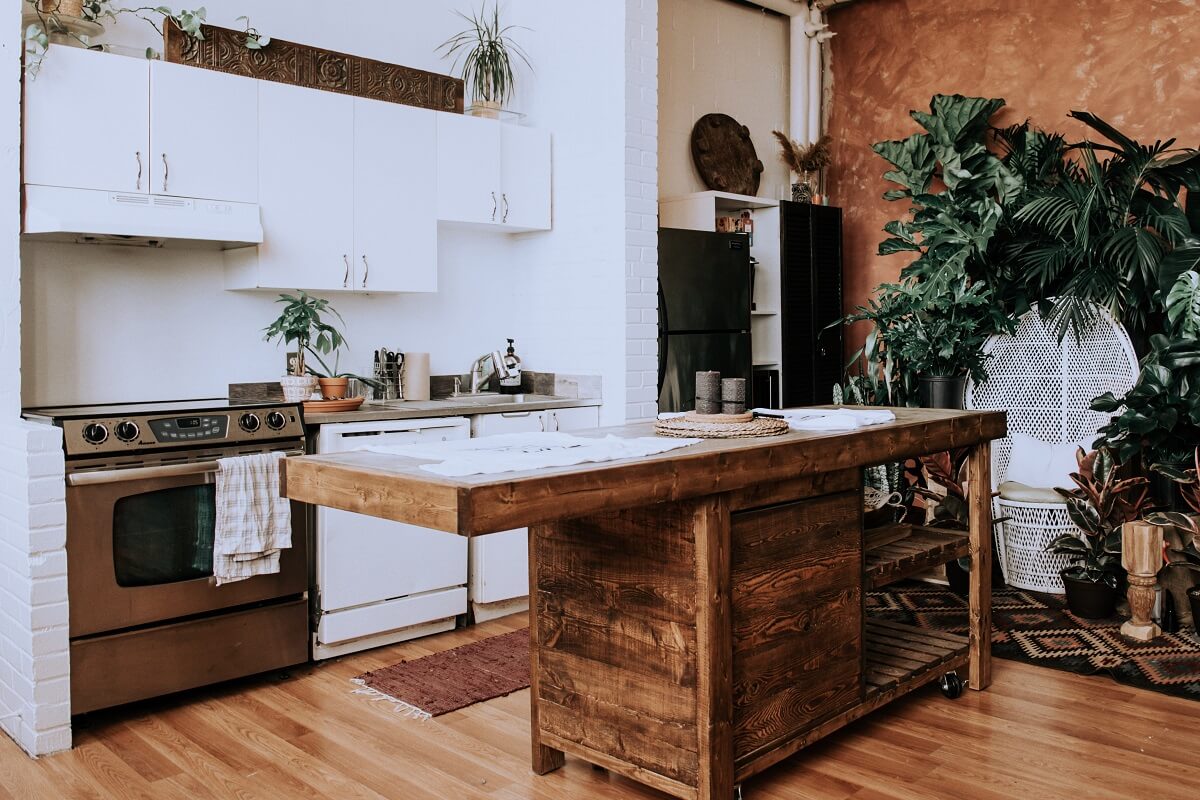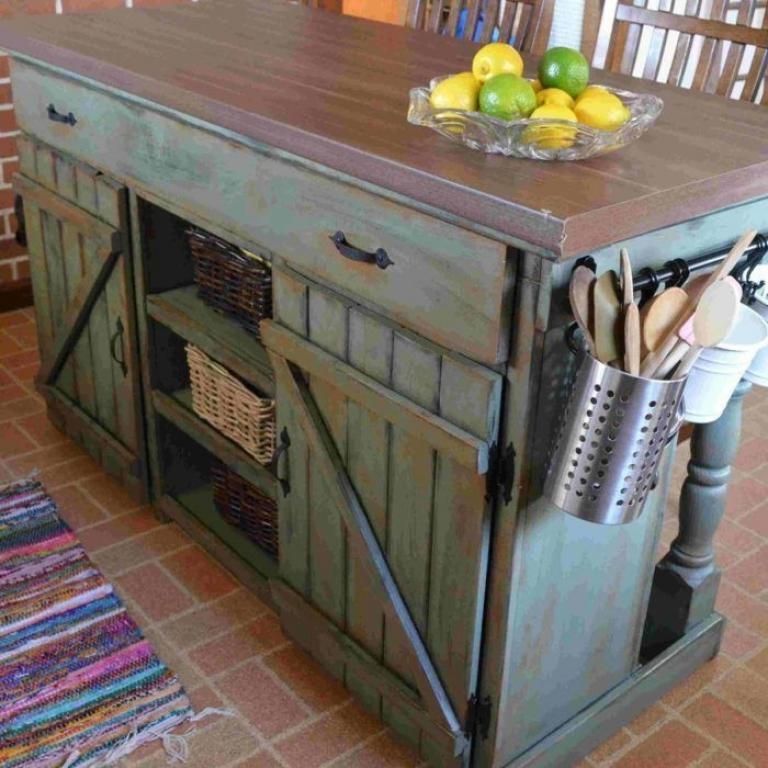DIY Kitchen Island: A kitchen island can be a game-changer, adding functionality and style to your space. Building your own lets you personalize it perfectly, from the size and shape to the materials and finishes. You’ll have the satisfaction of creating something unique and beautiful, tailored to your needs and budget.
Whether you’re a seasoned DIYer or a novice, the process of building a kitchen island is achievable with careful planning and execution. This guide will walk you through every step, from initial design to final finishing touches, helping you bring your vision to life.
Planning and Design: Diy Kitchen Island
Planning and designing your DIY kitchen island is a crucial step to ensure it fits your space, style, and needs. This section will guide you through the process, addressing key considerations and providing ideas for functionality.
Island Size and Shape, Diy kitchen island
Determining the ideal size and shape of your kitchen island is essential for a functional and aesthetically pleasing design.
- Measure your kitchen space: Before you start sketching, measure your kitchen accurately. Consider the available space, walkways, and the location of other appliances.
- Consider the size of your kitchen: A large kitchen can accommodate a larger island, while a smaller kitchen might require a more compact design.
- Plan for traffic flow: Ensure there is enough space for people to move around comfortably, especially if you plan to have seating at the island.
- Think about the shape: Rectangular islands are common and offer ample workspace, while L-shaped islands can be great for maximizing space in corner areas. Curved or circular islands can add a touch of elegance but might be less practical for workspace.
Materials for Your Kitchen Island
Choosing the right materials is key to achieving the desired look and durability for your kitchen island.
- Wood: A popular choice for kitchen islands, wood offers versatility in styles and finishes. Popular options include maple, cherry, and oak.
- Concrete: Provides a modern and industrial look, with a wide range of colors and finishes.
- Metal: Stainless steel or iron can add a sleek and contemporary touch.
- Stone: Granite, marble, or quartz are durable and elegant options but can be more expensive.
Incorporating Functionality
Think about how you want to use your kitchen island to maximize its functionality.
- Seating: If you plan to use the island for dining, consider incorporating seating. Bar stools or chairs are common options.
- Storage: Add drawers, cabinets, or shelves to create storage space for dishes, cookware, or other kitchen essentials.
- Appliances: Integrate appliances like a sink, dishwasher, or even a small cooktop for added convenience.
Finishing and Styling
Now that your kitchen island is built, it’s time to give it the finishing touches that will make it truly shine. This involves choosing the right finishes and adding decorative elements that complement your kitchen’s style.
Kitchen Island Finishes
Choosing the right finish for your kitchen island is crucial, as it sets the tone for the entire space. Here are some popular options:
| Finish | Description | Example |
|---|---|---|
| Painted | Offers a wide range of colors and can be easily customized to match your kitchen’s decor. | A bright white island with black hardware, creating a classic and clean look. |
| Stained | Enhances the natural grain of wood, adding warmth and character to the island. | A dark walnut stain, bringing a rustic and elegant touch to a farmhouse-style kitchen. |
| Laminate | Durable and affordable, available in various colors and patterns, including wood-look options. | A light gray laminate countertop with a subtle woodgrain pattern, providing a modern and practical solution. |
| Stone | Adds a luxurious touch and is highly resistant to heat and scratches. | A granite countertop with a swirling pattern, complementing a contemporary kitchen design. |
| Concrete | Offers a unique industrial aesthetic and can be customized with various colors and textures. | A polished concrete countertop with a smooth, gray finish, adding a modern and edgy feel to the kitchen. |
Painting, Staining, and Sealing
Proper preparation is key to achieving a beautiful and long-lasting finish. Here are some tips:
- Sanding: Before applying any finish, sand the island’s surface smooth to ensure even paint or stain application. Use progressively finer grits of sandpaper to achieve a smooth finish.
- Priming: Apply a primer to seal the wood and provide a better surface for paint or stain adhesion. Choose a primer that’s compatible with the finish you’ll be using.
- Painting: Apply paint in thin, even coats, allowing each coat to dry completely before applying the next. Use a high-quality brush or roller for a smooth finish.
- Staining: Apply stain according to the manufacturer’s instructions. Use a brush or rag to apply the stain evenly, wiping away any excess. Allow the stain to dry completely before applying a sealant.
- Sealing: Apply a sealant to protect the finish from spills, stains, and scratches. Choose a sealant that’s compatible with the paint or stain you used.
Adding Decorative Touches and Hardware
Decorative touches and hardware can elevate your kitchen island from functional to fabulous. Here are some ideas:
- Countertop Edge Detail: Consider adding a decorative edge to your countertop, such as a bullnose or ogee profile, for a more polished look.
- Hardware: Choose cabinet hardware that complements the island’s style. Consider knobs, pulls, or a combination of both. Don’t forget to add a stylish faucet to your island sink.
- Lighting: Install pendant lights above your island to create a focal point and provide task lighting. Choose fixtures that match the style of your kitchen.
- Storage Solutions: Add storage baskets, trays, or other organizers to keep your island tidy and organized. Consider using open shelving to display decorative items or cookbooks.
- Plants: Add a touch of greenery to your island with a small plant or herb garden. This can add a touch of life and color to the space.
Safety and Best Practices

Building a kitchen island is a rewarding project, but safety should always be a top priority. This section will guide you through essential safety precautions, best practices for a sturdy and safe island, and tips to prevent accidents and injuries.
Working Safely with Tools and Materials
When working with tools and materials, it’s crucial to follow safety guidelines to minimize the risk of accidents.
- Wear protective gear: Always wear safety glasses to protect your eyes from flying debris. Ear protection is also essential when using loud tools. Gloves can protect your hands from cuts and splinters.
- Use the right tools for the job: Using the wrong tool can lead to accidents. Make sure your tools are in good working condition and are appropriate for the task at hand.
- Follow tool instructions: Carefully read and understand the instructions for each tool before using it. Pay attention to safety warnings and operating procedures.
- Keep your work area clean and organized: A cluttered workspace increases the risk of tripping or falling. Clear away any debris and keep tools organized.
- Take breaks: Working for extended periods can lead to fatigue, which increases the risk of mistakes. Take regular breaks to rest and avoid exhaustion.
Building a Sturdy and Safe Kitchen Island
A well-constructed kitchen island provides stability and safety. Here are some best practices to ensure your island is sturdy and safe:
- Use high-quality materials: Choose durable materials that can withstand the weight of your island and the items you plan to place on it. Consider using plywood or solid wood for the base and countertop.
- Securely fasten all components: Use appropriate fasteners and ensure they are adequately tightened. This will prevent the island from wobbling or collapsing.
- Reinforce corners and joints: Use corner braces or additional supports to strengthen the island’s structure, particularly at corners and joints.
- Consider weight distribution: Evenly distribute the weight of the island to avoid stress points. If you plan to use heavy appliances or countertops, ensure the structure can support the load.
- Anchor the island to the floor: For added stability, consider anchoring the island to the floor using brackets or bolts. This is especially important if you have young children or pets.
Preventing Accidents and Injuries
Preventing accidents is crucial during the construction and use of your kitchen island.
- Be mindful of electrical wiring: If you’re incorporating electrical outlets or appliances, ensure all wiring is properly installed and grounded. Avoid running wires under the island, where they can be easily damaged.
- Use non-slip materials: Choose non-slip materials for the countertop and floor around the island to prevent slipping and falling.
- Keep sharp edges covered: Cover any sharp edges or corners on the island to prevent injuries.
- Avoid overcrowding: Leave adequate space around the island for movement and to prevent collisions.
- Use caution when lifting heavy objects: Always ask for help when lifting heavy objects to prevent strain or injury.
Budgeting and Cost Estimation

Creating a DIY kitchen island on a budget requires careful planning and cost estimation. By setting realistic financial goals and exploring affordable options, you can build a beautiful and functional island without breaking the bank.
Budgeting for a DIY Kitchen Island
Start by defining your budget and breaking down the costs into categories such as materials, tools, hardware, and any necessary professional assistance.
A good rule of thumb is to allocate 20% of your budget for tools and hardware, 60% for materials, and 20% for unforeseen expenses.
This allocation will help you stay on track and avoid unexpected financial surprises.
Finding Affordable Materials and Tools
- Shop Around: Compare prices from different retailers, both online and in-store, to find the best deals.
- Consider Used Materials: Check local salvage yards, flea markets, and online marketplaces for affordable used materials.
- Look for Sales and Discounts: Take advantage of seasonal sales, clearance events, and coupon codes to save money.
- Utilize Recycled Materials: Incorporate repurposed items like old doors, pallets, or even salvaged furniture to add unique character to your island.
- Buy in Bulk: If you need a large quantity of materials, consider buying in bulk to potentially get a discount.
- Borrow or Rent Tools: Instead of purchasing expensive tools you’ll only use once, consider borrowing or renting them from friends, family, or tool rental stores.
Minimizing Project Costs
- Simplify the Design: Opt for a simple design with minimal ornamentation and complex joinery.
- Choose Budget-Friendly Materials: Explore alternatives to expensive hardwoods, such as plywood, pine, or even MDF (medium-density fiberboard).
- Do It Yourself: Avoid hiring professionals for tasks you can handle yourself, such as painting, staining, and assembly.
- Plan Ahead: Carefully measure and plan your design to avoid costly mistakes and material waste.
- Utilize Free Resources: Look for free online resources, such as tutorials and project plans, to guide your construction.
Closing Notes
Building a DIY kitchen island is a rewarding experience that allows you to create a functional and stylish centerpiece for your kitchen. With careful planning, attention to detail, and a touch of creativity, you can craft a kitchen island that perfectly complements your space and reflects your unique style. So, gather your tools, unleash your inner builder, and embark on this exciting DIY journey!
A DIY kitchen island can be a great way to add extra counter space and storage to your kitchen. If you’re looking for a project that will allow you to get your hands dirty and learn new skills, building a kitchen island is a great option.
You can even incorporate some of the same skills you learned from building a DIY greenhouse like using wood framing and assembling panels. A DIY kitchen island can be a rewarding project that will add a touch of personal style to your home.